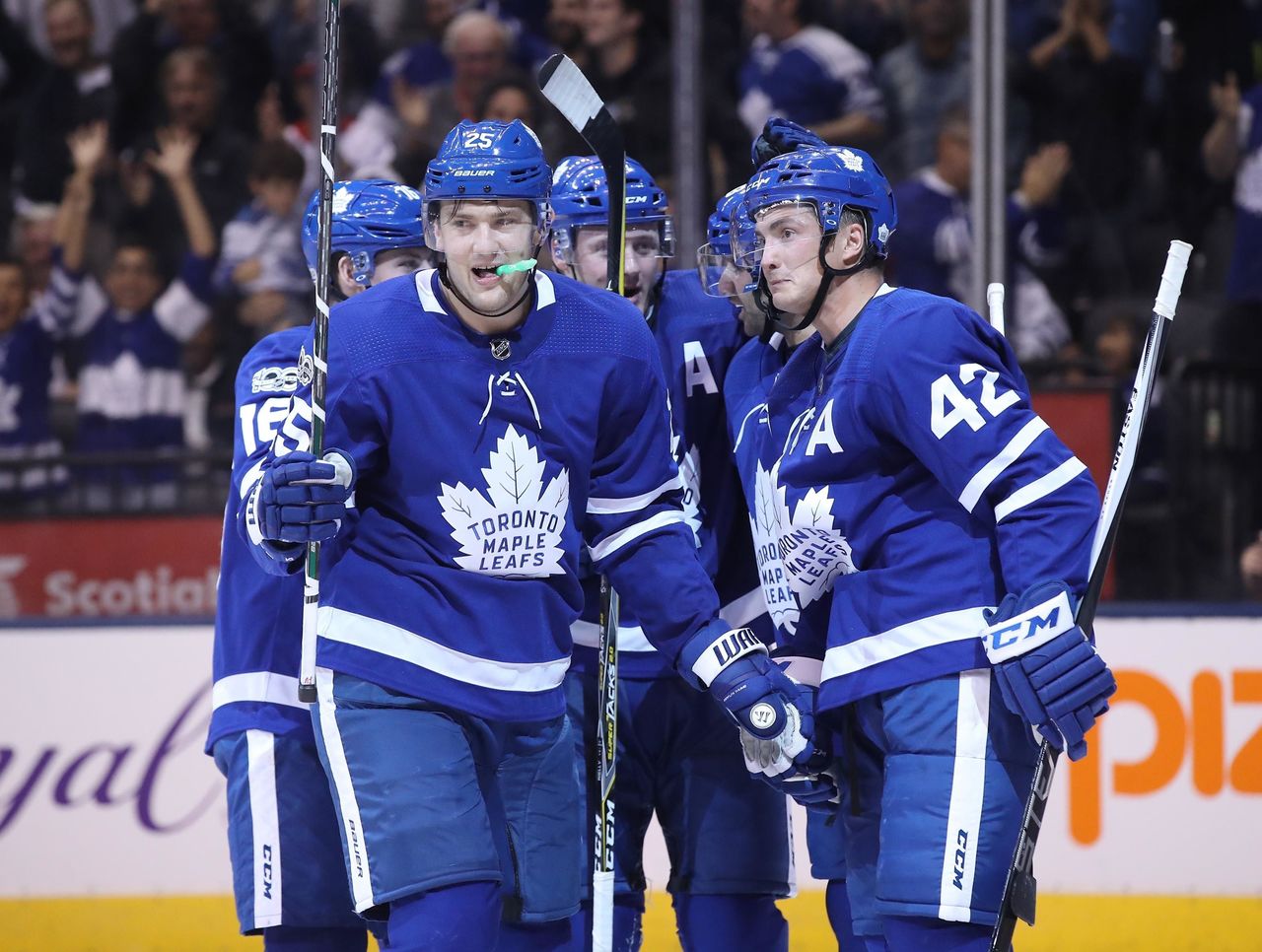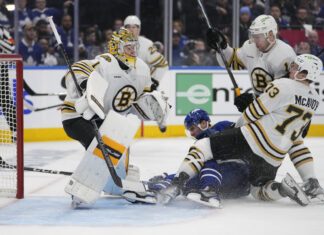Three games into the Toronto Maple Leafs season, Joel Quenneville has summed it up best so far: “They’re good. They’re really good. They’ve got some amazing players.”
There is no question that this is a strong Leafs team – the strongest since the 2004 Sundin-led roster that lost in the second round to the Philadelphia Flyers. To get a rough idea of how good they really are, though, we’ll have to wait until American Thanksgiving, which will take the team through 23 games played.
They are the early leaders in goals per game, averaging over six per game through the first three, and are rolling four lines with ease. The team has given up 10 goals in the same three games, but a lot of that is due to building early leads and then getting impacted by score effects, including the Rangers coming all the way back from a four-goal deficit. That is what makes the team so difficult to analyze as a whole just yet – they blew their first two opponents out of the water in the first and then sat back. It almost ended up costing them the second time, but they were still able to recover and secure the two points.
Regardless, these kinds of games with huge early leads make it very difficult to evaluate the team as a whole other than to say they have a lot of offensive firepower.
The Blackhawks offered the first real test – including the first time this season that the opponent scored first and held a lead against them. Toronto dominated. In this case, a picture says 1,000 words:
You could not have asked for a better start if you are Toronto. Everyone is on the scoreboard, they are 3 – 0 — including a previously-elusive OT win — and when push came to shove, they were handily better than all three of their opponents to date.
It’s early, and most seem to be aware of that, but boy is it difficult not to get excited about this season right now.
Notes
– The offense is getting a lot of the attention, but Frederik Andersen has been fantastic to start the season. The Jets had a parade of power plays early in the season opener, and Andersen held the team in it, including a big save on Patrik Laine. The lead got away from the team against the Rangers, but he managed to reset and close the door. Against Chicago, he had a big save on a Patrick Sharp breakaway to keep it at a two-goal game. The team is still leaky defensively, and while he might not need to steal them games very often, the team is also rarely going to make his life easy.
– Easy to forget now, but Connor Brown (probably) saved a goal in the final minute of the second period against Winnipeg with a backcheck and stick lift on an open net. The Chicago game saw him get his first goal and points on the season (he only had one shot on net going into the game), but he manages to make contributions all over the ice whether it’s on the scoreboard or not. Babcock gave him a nice reward by moving him up the lineup and playing him to start overtime with Nazem Kadri – that would usually be Komarov’s spot.
– The game was all but over and he made it look easy, but that was a beautiful goal Nazem Kadri managed to score against the Rangers. We’ve seen that move from Kadri before. In junior, he used to get the puck on his forehand and cut in while flipping the puck in the air. He’s tweaked that move to NHL standards.
– Patrick Marleau got the headlines for a great debut including a beautiful goal, but what’s really interesting is that he led all forwards in ice time against Chicago with 21:34 played. The next highest was Auston Matthews at 18:51. We know Babcock loves him from the Olympics, and now he has him on the shutdown line, sneaks him out with Matthews after penalty kills, and gives him top power play time. He has nine shots on net through three games. You can see his skating is still there, but what is really underrated game is how physical he is along the walls. It’s not hit-and-hurt physical; it is body positioning and using his 6’2, ~220-pound frame to win battles and dig pucks out. You can tell that he has played his whole career in the Western Conference.
Kadri or Marleau with Matthews and Nylander is the team’s most dangerous line.
– Against the Jets, Babcock played the third pairing in the third to try to help their confidence, and they got burned a few times. Andreas Borgman had a bad giveaway up the middle and was walked by Ehlers on the PK. On Perrault’s goal, both Connor Carrick and Borgman got caught. In his Chicago return to the lineup, Borgman had a few sequences where he made strong initial reads to beat the first forechecker, and then missed out on executing the pass with the puck – his skills clearly need work. Against Chicago, there was one particular sequence where he went to get the puck on a dump-in and spun off the forechecker before missing Tyler Bozak in the middle of the ice with a pass. The puck came back to him and he evaded another forechecker before going weak up the boards and getting stuffed.
– I was surprised to see Calle Rosen receive PP time in a tight game against Chicago. He took a penalty on the play, but that aside for a second, it speaks to what the coaching staff thinks of him to even have him out there. On the play there, he took a step towards his man on the breakaway ice – what you’re supposed to do is skate directly to the net and cut off the post; it saves you a step.
– The Auston Matthews line had 29 even-strength shot attempts to three against Chicago. He somehow looks better than he did in his 40 goal rookie season. Matthews and William Nylander combined for 11 shots on net in that game and had the puck on a string all night long.
– I still think William Nylander could play center and be a high end one, but how do you break those two up? You couldn’t justify it at this point.
– The early overtime pairs:
Kadri – Brown
Matthews – Nylander
Marleau – Marner
Bozak – JVR
That will do.
Quotes
“Obviously, we started like a house on fire. We were really going and playing well. You saw this kind of thing last year at times where we just kind of lose our way. We did that, but we had enough stability and talent to stick with it and we ended up getting the win.”
– Mike Babcock after the win against the Rangers
Thought this was an astute observation by Babcock relating back to last year’s issues with early leads. Toronto finished the season eight points behind the division winner and lost eight games in the shootout – nobody else lost even seven last year. They also blew a collection of early leads and left relatively easy points on the table. The firepower is clearly there. This is the kind of stuff they need to clean up now.
“Fehr played great last game. I’m sure this was a predetermined thing to put Moorsy in tonight. But that’s the really good thing about having two players like that who can play the same role. We’re lucky to have that problem.”
– Connor Brown on his two fourth line centers
Of note, Fehr is from Winnipeg and Moore is from Toronto. I don’t completely believe Babcock believes in that kind of goodwill, but I wonder if the 6’4 Fehr got in because the Jets are a big, physical team and the 5’10 Moore went in because the Rangers are speedy and skilled.
“Trying to go for the lady byng this year. It’s not going to be easy”
– Leo Komarov after the Jets game and an ominous penalty for tilting his visor
He’s the funniest and most interesting guy on the team. Still.
Video Tidbit of the Week
Can we also please discuss this shift by Marner, Marleau, and Zaitsev? pic.twitter.com/O7k4EvzY88
— Flintor (@TheFlintor) October 10, 2017
I am not going to break this shift down frame by frame, but it is a work of art and I’d be remiss if I didn’t mention Mitch Marner anywhere in this Notebook. Keep an eye on how he uses his edges at the 3:10 mark to protect the puck and create space for himself.
Nikita Zaitsev looks very comfortable to start the year with two goals and two assists, and he’s currently on pace for 30 more shots on goal than last season.
You will also see a lot of great work from Marleau in front of the net – again, an example of his underrated physicality. He has often been known as a soft player, and he’s certainly not going to crush anyone with a body check anytime soon, but he goes to all the dirty areas and makes things happen.
5 Things I Think I’d Do
1) I think, as a fan, I would take the forward lines with a grain of salt. Babcock is really mixing and matching – particularly after a special teams event — and trying different line combinations. Connor Brown is getting steady special teams time – he’s far beyond a fourth liner on this team. In training camp, Babcock noted that the lines always work themselves out as the season goes on and the best players will end up playing; not even a week in, I would be looking for things that work on a shift-by-shift basis, instead of obsessing over the pre-game lines that are tweeted out.
2) I think it makes the most sense to have Calvin Pickard playing in the AHL and Curtis McElhinney sitting on the bench as the backup. A lot has been written about McElhinney’s overall track record – including in this space – but he hasn’t played a game yet and was serviceable for the Leafs down the stretch last year. I’d let it go for the time being as Andersen is going to carry the bulk of the workload anyway.
3) I do think a Moore – Fehr – Brown line would be interesting to see, but I don’t think Matt Martin is coming out anytime soon (and he has done his job well so far). I think I would be starting Dominic Moore over Eric Fehr though – his speed and skill is beyond Fehr’s and that gives Brown a reasonable player to ride shotgun with. After scoring and going 9/9 on the faceoff dot, I was surprised he wasn’t back in again.
4) I think, if Connor Brown keeps playing well, he’ll be bumping Leo Komarov down the lineup regularly. And that’s not a knock on Komarov, but there is just nobody else you would bump down at this point.
5) I think that I mentioned that the third defence pair would struggle – and they have – and that everyone will need to be patient with them. Carrick sat because he was banged up (apparently), but I would pair up Borgman and Carrick for a few weeks and then evaluate from there. Borgman does need to work on his puck skills, but his physicality helps him break up plays in the defensive zone and he adds a physical element to the defense that is generally lacking, as well as a potential penalty killing option.


































